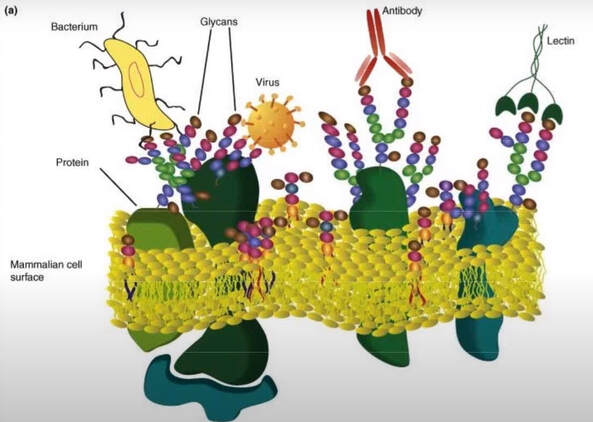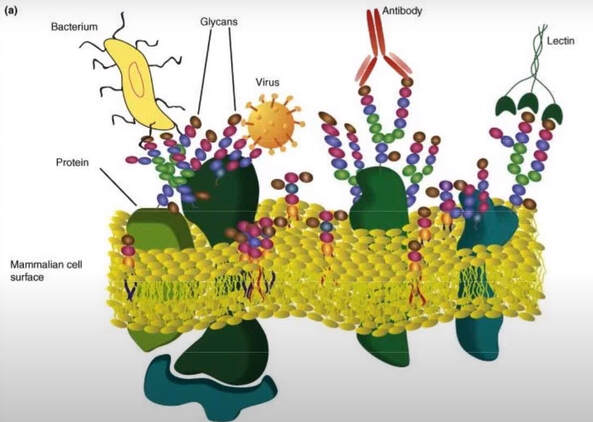|
Cells communicate to each other and to the immune system cells through a series of what looks like fuzz on their surfaces. This fuzz, when looked at through an electron microscope looks more like antenna than anything else. It is composed of a combination of sugar molecules (glyco or glycan), protein molecules (that always begin with the letter l or the word proteo), and fat molecules (that always start with lipo or lipid). These glycoprotein and glycolipid structures on the surfaces of cells—called glycans—communicate their needs: to be nourished, defended, repaired, or destroyed – when they are too damaged to be repaired to other cells, bacteria and viruses. And… if they don’t get the right nutrition, they can become malformed and result in flawed information communicated to other cells or within the cells, themselves. Poor cellular communication results in cancer, auto immune conditions, reduced cognition, and even some genetic conditions.
The science of glyocomics or glycobiology has studied glycans and their functions since the 1990’s, where researchers demonstrated that glycans to be the most significant area of animal and human physiology. A glycan is an individual sugar molecule that is attached to either another sugar molecule, a fat molecule, or a protein molecule. Wait… Glycans are SUGARS? Yikes! Many people still incorrectly assume that all sugars or carbohydrates only supply energy inside the body and can contribute to inflammation and that cancer cells love to consume. That was disproved in the 1990’s! You see, in biochemistry, all sugar molecules end in ‘ose’. For example, both celery and paper (made of cellulose) are sugars, biochemically. Not All Sugars Are Sweet So What? Our bodies actually need non-nutritive sugar molecules to make glycans so our immune systems and brain will work. The most useful term for these foods is ‘glyconutrients’. Many sugars that build healthy glycans come from saps and gums, and seaweed—in other words, they aren’t something you regularly find in the grocery store. But the problem is that we need adequate nutrients, enzymes, and a healthy gut to turn food into glycans. In those cases, our bodies don’t have the cellular metabolism (energy) to break down the food and convert the sugars to cellular communication structures. In the past 30 years we have seen over and over again the benefits that result from people supplementing their diets with glyconutrients because they actually have a profound effect on the immune system and support cognitive and digestive function, as well https://mannatechscience.org/product/ambrotose-life-powder/. So, this is something that is very important for people to supplement. It’s difficult to get glyconutrients from food. You would need to eat “roots, tubers, and the organs of small animals” to get the foods that the body can easily convert. However, dietary supplements that supply glyconutrients, like stabilized aloe vera gel (acemannan), arabinogalactan, astragalus, and brown seaweed, can provide what you need that is missing in your diet.
0 Comments
Leave a Reply. |
Details
AuthorCarol Merlo is a health and wellness author and educator. ArchivesCategories |


 RSS Feed
RSS Feed